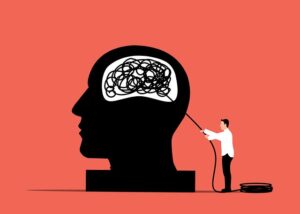I understand that life can be overwhelming and hectic at times. With the constant demands of work, family, and other responsibilities, it can be challenging to find time for self-care. However, taking care of yourself is crucial for your mental and physical wellbeing.
That’s why I want to share with you some quick and easy stress reduction exercises that you can incorporate into your daily routine. These exercises are designed to help you relax, reduce anxiety and tension, and improve your focus and productivity. The best part is that they only take 10 minutes or less to complete, so you can easily fit them into your busy schedule.
Whether you’re at home or work, these exercises will help you create a calm and peaceful state of mind that will carry you through even the most stressful days. So let’s dive in and explore 10-minute stress reduction exercises that will transform the way you approach your daily routine.
Mindful Breathing Techniques
 Mindful breathing techniques are a powerful tool in reducing stress and anxiety. The simple act of focusing on your breath can help you calm your mind and relax your body.
Mindful breathing techniques are a powerful tool in reducing stress and anxiety. The simple act of focusing on your breath can help you calm your mind and relax your body.
One technique is called breath counting, where you count each inhale and exhale up to a certain number, such as 10 or 20. This helps bring your attention back to the present moment and away from racing thoughts.
Visualization exercises are another effective way to practice mindful breathing. Close your eyes and imagine yourself in a peaceful place, such as a beach or forest. As you inhale, visualize yourself taking in the tranquility of the environment, and as you exhale, release any tension or negativity from your body. This technique helps create a sense of relaxation and reduces stress levels.
It’s important to note that mindful breathing techniques take practice to master. You may find it difficult at first to focus solely on your breath without distractions, but with consistent practice, it becomes easier over time.
Incorporating these exercises into your daily routine for even just a few minutes can make a significant impact on reducing stress levels. By incorporating breath counting and visualization exercises into your daily routine, you can quickly reduce stress levels when needed.
These techniques help bring awareness to the present moment, allowing you to let go of any worries or anxieties that may be causing stress. With consistent practice, these mindful breathing techniques become natural responses during times of stress, helping you maintain a sense of calm throughout the day without disrupting your routine.
Progressive Muscle Relaxation
After practicing mindful breathing techniques, it’s time to move on to progressive muscle relaxation. This technique involves tensing and then releasing each muscle group in your body, helping you to become more aware of physical sensations and release tension. The benefits of this exercise are numerous, including reduced anxiety, improved sleep, and increased overall relaxation.
One tip for incorporating progressive muscle relaxation into your busy schedule is to start small. Set aside just five minutes each day to practice this exercise, gradually increasing the amount of time as you become more comfortable with the technique. Another suggestion is to use a guided meditation app or video to help you stay focused during the exercise.
As you begin the exercise, start by tensing and releasing your feet and toes before moving up to your calves, thighs, buttocks, abdomen, chest, arms, hands, neck, and face. As you tense each muscle group for about five seconds before releasing it for 10-15 seconds while focusing on the sensations in your body.
By incorporating progressive muscle relaxation into your daily routine on a regular basis, you can significantly reduce stress levels and improve overall well-being. So take a few minutes out of your day to practice this simple yet effective exercise – your mind and body will thank you!
Guided Imagery Meditation
Visualizing a calm and peaceful image is an effective way to reduce stress and anxiety. Guided imagery meditation is a technique that involves using your imagination to create a visual representation of relaxation. Visualization techniques can help you relax by taking your mind off the present moment and into a calming place.
To incorporate guided imagery meditation into your daily routine, find a quiet place where you can sit or lie down comfortably. Close your eyes and take deep breaths in through your nose and out through your mouth. As you breathe, focus on relaxing each part of your body from head to toe.
Now imagine yourself in a serene location such as a beach, forest, or mountain top. Incorporate senses into meditation by imagining the sounds of waves crashing against the shore or birds chirping in the trees. Feel the warmth of the sun on your skin, smell the salty sea air or fresh pine trees, and taste the sweetness of fresh fruit.
Practice guided imagery meditation for five to ten minutes each day to improve overall well-being and decrease stress levels. Remember that this technique takes practice and patience, so don’t get discouraged if it doesn’t work right away. With time and consistency, this method can become a powerful tool in managing stress and anxiety.
By incorporating visualization techniques and using all five senses during meditation, you can create an immersive experience that promotes relaxation and reduces stress levels. Make guided imagery meditation a part of your daily routine for improved mental health and wellbeing.
Yoga And Stretching Exercises
After practicing guided imagery meditation, it’s time to move your body and stretch out those muscles.
Incorporating yoga and stretching exercises into your daily routine can have numerous benefits for your mind and body.
One of the key benefits of flexibility is improved joint health and mobility.
As we age, our joints can become stiff and less mobile, leading to discomfort and even pain.
Regular stretching through yoga can help keep joints flexible and reduce the risk of injury.
Yoga is also a great exercise for beginners because it is low-impact and can be modified to suit different levels of fitness.
There are many online resources available with beginner-friendly routines that you can do from the comfort of your own home.
Incorporating just a few minutes of yoga or stretching exercises into your daily routine can make a big difference in how you feel both physically and mentally.
So why not give it a try? Your body (and mind) will thank you!
Expressive Writing And Journaling
Have you ever tried expressive writing or journaling as a stress reduction technique? Writing down your thoughts and feelings in a safe space can be extremely beneficial for your mental health. It’s like having a conversation with yourself, without any outside judgment or interruptions.
Benefits of Journaling:
- Helps to process emotions
- Improves cognitive functioning
- Lowers stress levels
- Provides an outlet for creativity
- Increases self-awareness
There are many different journaling techniques that you can try, such as free writing, gratitude journaling, and bullet journaling. Free writing involves setting a timer for a certain amount of time and just letting your thoughts flow onto the paper without worrying about grammar or structure.
Gratitude journaling involves writing down things that you are thankful for each day. Bullet journaling is a more structured form of journaling, where you create lists and trackers to help organize your thoughts and goals.
Whatever technique you choose, make sure to set aside some time each day to write in your journal. It doesn’t have to be long – even just 5 minutes can make a difference.
Remember that this is your personal space to express yourself freely and without judgment. Use it as an opportunity to gain insight into your own mind and improve your overall well-being.
Incorporating expressive writing or journaling into your daily routine can greatly reduce stress levels and improve mental health. Give it a try – who knows what insights you might uncover about yourself!
Frequently Asked Questions
How Often Should I Practice These Exercises?
As a wellness and stress reduction expert, I recommend practicing these exercises at least once a day to reap the full benefits.
The ideal time of day may vary depending on your schedule and personal preferences, but it’s important to find a consistent time that works for you.
Whether it’s in the morning to start your day off right or in the evening to wind down before bed, make sure to set aside a few minutes each day for mindfulness and relaxation.
Remember, consistency is key when it comes to reducing stress and improving overall well-being.
Can These Exercises Be Done While Sitting At A Desk Or Do I Need To Find A Quiet Space?
To truly alleviate stress, it’s important to investigate the truth of theories and find what works best for you.
When it comes to desk-friendly stress reduction, there are certainly advantages to finding a quiet space. However, that doesn’t mean exercises can’t be done while sitting at your desk.
In fact, taking just a few minutes throughout the day to practice deep breathing, stretching, or meditation can help reduce tension and improve focus.
As a wellness and stress reduction expert, I encourage individuals to experiment with different methods and see what works best for their unique needs and environment.
### Are There Any Health Conditions That May Prevent Me From Doing These Exercises?
Managing stress can be challenging, especially for those with chronic illness or physical limitations.
When it comes to reducing stress, it’s important to listen to your body and modify exercises accordingly.
For example, if you have joint pain, try yoga poses that are gentle on your joints or opt for seated exercises instead of standing ones.
It’s also important to talk to your healthcare provider before starting any new exercise routine, especially if you have a chronic illness or medical condition.
Remember, managing stress is about finding what works best for you and your body.
Can I Do Multiple Exercises In One 10-Minute Session?
Absolutely! Combining multiple stress reduction exercises into a 10-minute session can be an effective way to manage stress and improve overall well-being.
Time management is crucial in today’s fast-paced world, so incorporating a variety of exercises such as deep breathing, yoga stretches, and guided meditation can help maximize the benefits in a shorter period of time.
It’s important to listen to your body and adjust the intensity or duration of each exercise as needed.
Remember, even small amounts of daily practice can lead to significant improvements in managing stress levels.
How Long Will It Take To See The Benefits Of These Exercises?
As a wellness and stress reduction expert, one of the most common questions I receive is how long it will take to see the benefits of stress reduction exercises.
While everyone’s experience will vary, studies have shown that regularly practicing stress reduction techniques can lead to reduced levels of stress and anxiety in as little as four weeks.
However, measuring the effectiveness of these exercises goes beyond just a timeframe. It’s important to pay attention to your own physical and emotional responses to these exercises and make adjustments accordingly.
Remember, finding what works best for you is key in creating a personalized stress reduction routine that can be incorporated into your daily life.
Conclusion
Incorporating stress reduction exercises into your daily routine can have a significant impact on your overall well-being. By taking just 10 minutes out of your day to focus on relaxation and mindfulness, you can reduce stress, improve sleep quality, and boost your mood.
Whether you choose to do these exercises at your desk or in a quiet space, the benefits are undeniable. And don’t worry if you have health conditions that may prevent you from doing certain exercises – there are plenty of modifications available to make them accessible for everyone.
So why not give it a try? With just 10 minutes a day, you can start feeling more calm and centered in no time. Remember, self-care isn’t selfish – it’s essential for living a healthy and fulfilling life.





